Walter Gropius as the father of the Bauhaus

Walter Gropius was the founder of the Bauhaus school of design, also known as the father of the Bauhaus. He was the director of the Bauhaus in Germany from 1919 to 1928. Later he headed the architectural design section at Harvard University’s Graduate School of Design. In the beginning of nineteens he studied architecture in Berlin and Munich. After a year of travel in Europe, Gropius joined the architecture office of Peter Behrens in 1908. At the time, Behrens was one of the most well-known architects and industrial designers in Europe. There were other modernists working in that office including Mies van der Rohe and Le Corbusier (The German Way and More, n.d., para. 1-2).
In 1910 Gropius partnered with Adolf Meyer to set up an architectural practice in Berlin. They designed the Fagus-Werk Factory for a shoe company in Germany. It was his first notable building, made of steel and glass with large banks of windows to let light in from the exterior to interior spaces. Gropius kept it simple and did not add any decoration to surfaces, unlike many building styles of the time. Which ended up that The Fagus-Werk Factory is often considered the first modern building. (Przybylek, n.d., para.2). Engels and Meyer (2006) stated that to some extent, Gropius and Meyer followed De Stijl design principles but only with regard to a few visible features such as the wall, the roof slabs, and asymmetrically placed fireplace (p. 22).
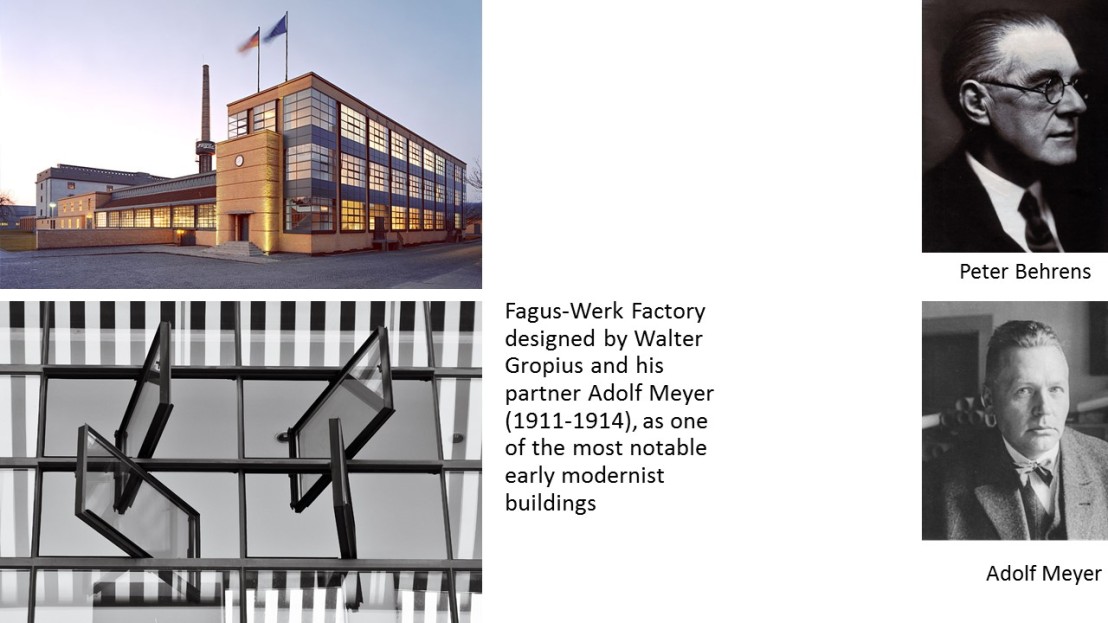
Bauhaus
Van de Velde is the most international artist of the Art Nouveau movement and one of the major. He was one of the first modern architects to develop the theory “form follows function”. In 1902 Van de Velde was asked to design two buildings for his School of Art and Applied Arts in Weimar where the Bauhaus style of architecture emerged. Van de Velde was the director of the school for fifteen years. With the outbreak of World War I he was forced to return to his native Belgium. As the successor of Henry van de Velde, Gropius became the director of the School of Arts and Crafts in Weimar and merge it with the Weimar Academy of Fine Art, which he renamed Staatliches Bauhaus Weimar (Folsom, F.J, 2013, para. 5-8). The name “Bauhaus” was selected for its allusion to the masons’ guilds of the medieval cathedrals, which combined art and craft in the collaborative undertaking (Manifesto, n.d., para. 1).
Gropius explained the idea of the Bauhaus in the founding Manifesto. In the text of the Manifesto, Gropius does not demand a new style or a new form of art, but much more fundamentally a reform of artistic work. This reform was described as an attempt to unify all forms of art and design, ranging from painting and craftwork to industrial and architectural design. The aim of establishing a new art of architecture would be achieved by unity of disciplines of architecture, sculpture and painting. The crafts-based work was understood as the ideal unity of artistic design and material production. According to Gropius’s curriculum, education at the Bauhaus began with the obligatory preliminary course, continued in the workshops and ended up in the building. (Walter Gropius, n.d., para. 6).
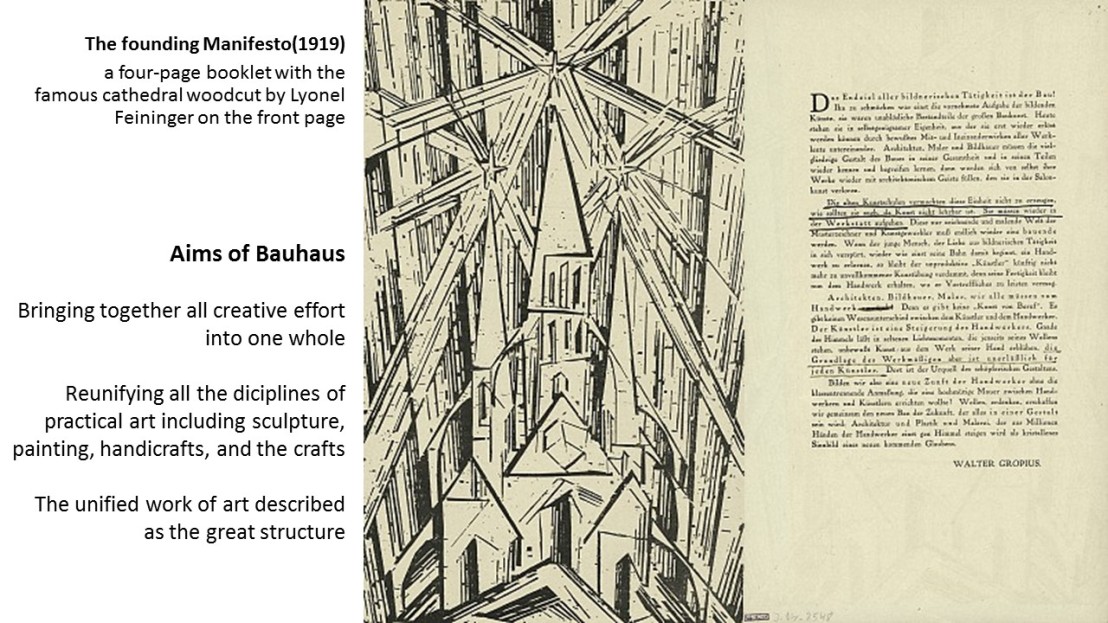
In the Program of the Staatliche Bauhaus in Weimar (1919), Principles of Bauhaus were stated:
The school was the servant of the workshop. There were no teachers or pupils in the Bauhaus but masters and journeymen.
Also the manner of teaching was supposed to be derived from the character of workshop. Like organic forms developed from manual skills.
Mutual planning of utopian structural designs should have been worked by collaboration of all masters and students — architects, painters, sculptors — In that way a harmony of all component elements and parts creating architecture could be achieved.
Constant contact with the leaders of the crafts and industries of the country as well as contact with public life through exhibitions and other activities were expected from students.
Encouragement of friendly relations between masters and students outside of work; therefore plays, lectures, poetry, music, costume parties. Establishment of a cheerful ceremonial at these gatherings (para. 8-18).
Workshops
Gropius believed in collaboration and attracted well-known artists and architects to the Bauhaus. Some of them were JosefAlbers, Hinnerk Scheper, Georg Muche,László Moholy-Nagy, Herbert Bayer, Joost Schmidt, Walter Gropius, Marcel Breuer, Wassily Kandinsky, Paul Klee, Lyonel Feininger, Gunta Stölzl, Oskar Schlemmer. These men as the masters of Bauhaus managed workshops based on their profession. For instance Lyonel Feininger conducted the graphic painting workshop, Johannes Itten the metal workshop, Paul Klee the weaving workshop and Oskar Schlemer the theater workshop.
The school’s most innovative educational aspect was its dualistic approach to training in the workshops, which were codirected by a craftsman, as the master of works, and an artist, as the master of form. It was defeated that there is no essential difference between the artist and craftsman. Only craft work, rather than art, is capable of being taught, so the Bauhaus theory was based on craft training in workshops (Walter Gropius, n.d., para. 6).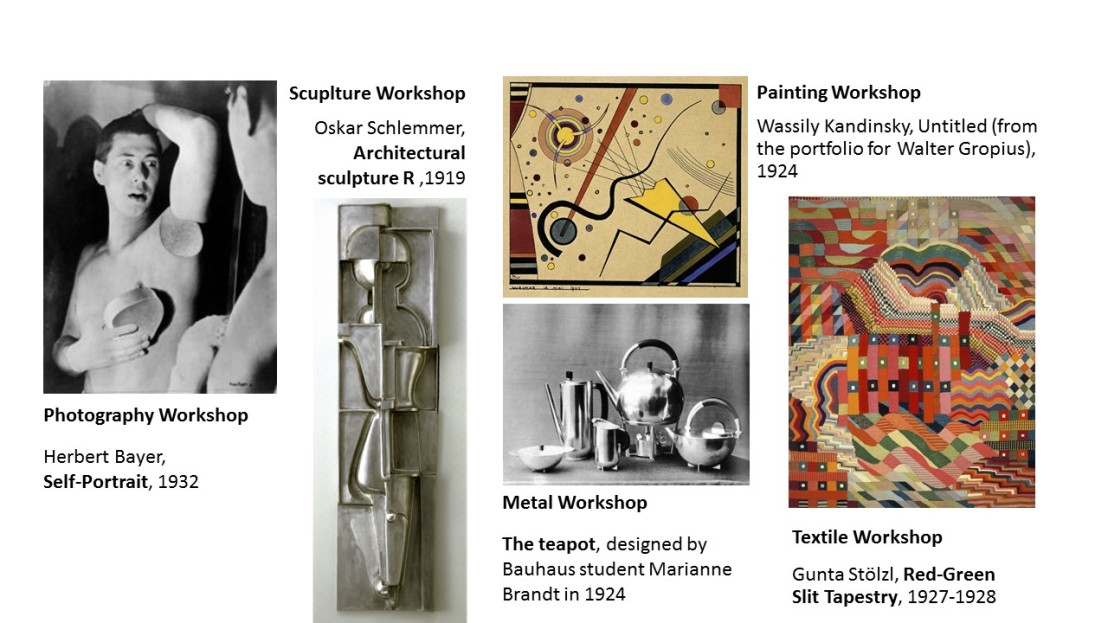
For commercial graphics workshop, Moholy-Nagy introduced the ideas of the New Typography to the Bauhaus starting in 1923. From then on, typography began to play a decisive role in the Bauhaus’s publicity work and in the development of a distinctive look for the college. He combined text and photography into interrelated compositions of pure communication named as typofoto (the Bauhaus collection: commercial graphics, n.d., para.1). In terms of typography, Bayer made use of the simplest geometric elements. His goal was the standardisation of communication processes and the development of a uniform typographic presence for the Bauhaus (Printing and advertising workshop, n.d., para. 2).
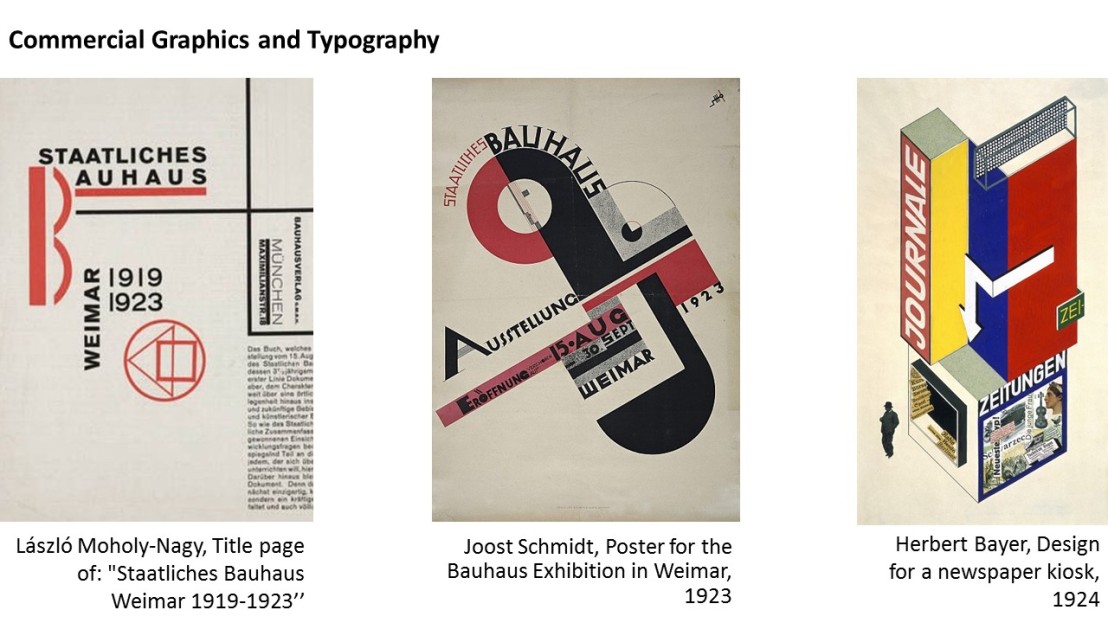
The Furniture Workshop at the Bauhaus was headed by Marcel Breuer from 1925 to 1928. During that time, he designed the first tubular steel chair in the history of design inspired by steel tubes of his bicycle. It determines the Bauhaus philosophy in a way of being simple design, mass produced, modern, satisfactory aesthetically and as a product for the general public. Simplicity and geometric purity were the main issues to achieve good design as well functionality in Bauhaus (the Bauhaus collection: furniture, n.d., para. 2).
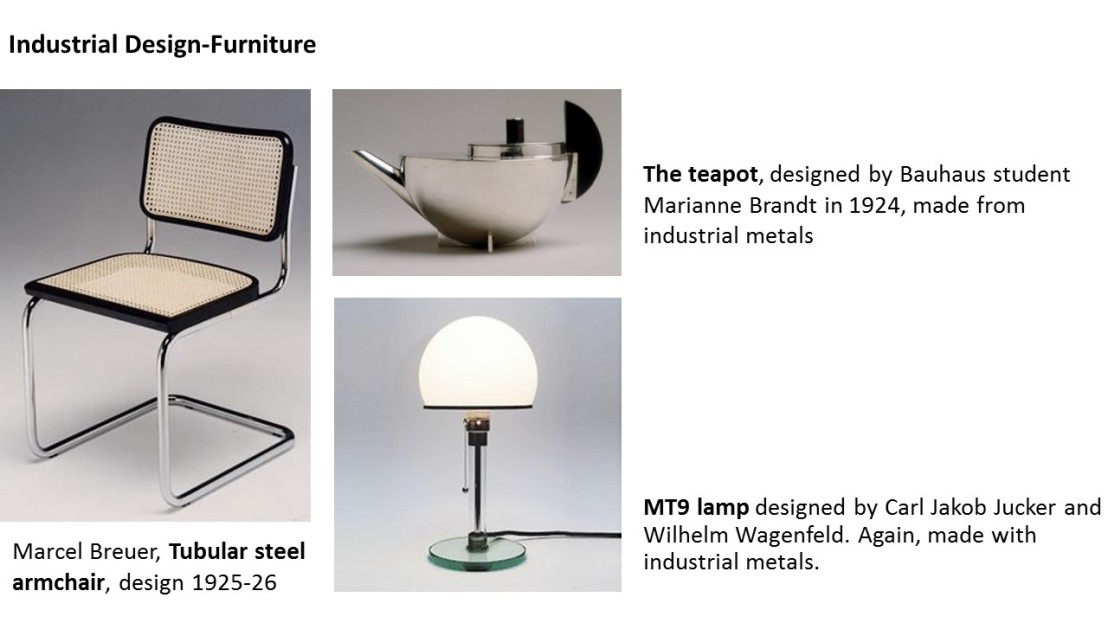
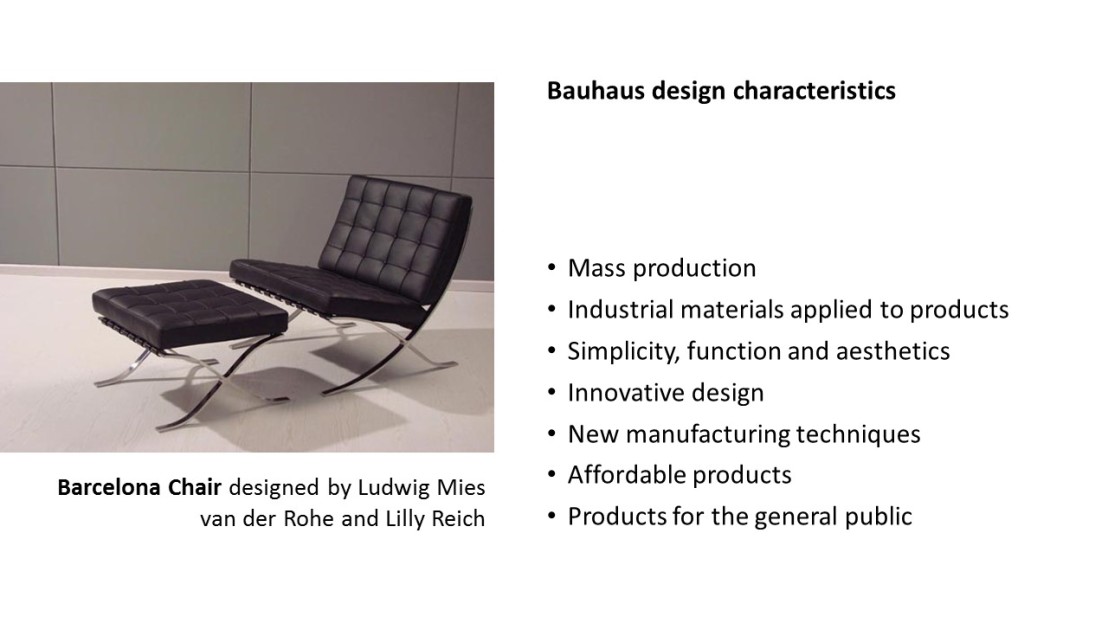 Architecture in Bauhaus
Architecture in Bauhaus
In the early years there was more focus on arts and crafts. Although its very name meant “house of building,” the Bauhaus would not offer classes in architecture until 1927. Architectural work was perceived as a whole derived from the interior design to landscaping.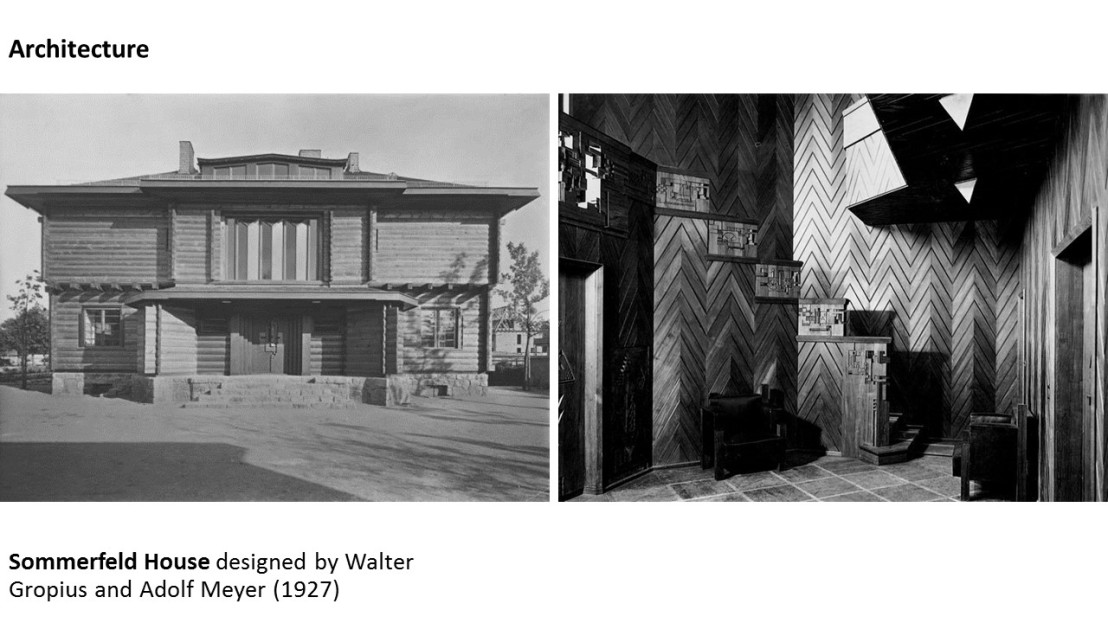
Sommerfeld House in Berlin is the first major joint project of the Bauhaus and a product aimed to create a “unified work of art.” It was designed by Walter Gropius and Adolf Meyer and furnishings were designed by the students of Bauhaus. Any object in the house was thought as a part of whole. According to Gropius, the wood corresponded to ‘the primitive, initial state of
our life that is being newly constructed. All of the arts were applied in the building in a programmatic way: for example, Joost Schmidt gave the beams a sculptural treatment, Josef Albers designed coloured glass windows, and Marcel Breuer designed some of the furniture (the Bauhaus collection: architecture, para. 1).
 The Haus am Horn is an experimental residential house and-prototype of residential housing approach of Bauhaus-planned by Walter Gropius and Fred Forbat as part of the first Bauhaus exhibition in 1923. It was designed by the painter Georg Muche for functions required by modern living conditions and social needs of a family. So there was a main space- an ideal main living room-surrounded by other differently sized spaces in a way of balancing the rigid geometry of the resulting building. The furniture was designed by Marcel Breuer, the lights by Laszlo Moholy-Nagy. All interiors were fabricated in the Bauhaus workshops. So again all of the arts played a role in a programmatic way as such in the Sommerfeld House. And only both House in the Horn and Sommerfeld House were the projects of Bauhaus in Weimar which were actually built (Engels, H., & Meyer, U., 2006, p.20).
The Haus am Horn is an experimental residential house and-prototype of residential housing approach of Bauhaus-planned by Walter Gropius and Fred Forbat as part of the first Bauhaus exhibition in 1923. It was designed by the painter Georg Muche for functions required by modern living conditions and social needs of a family. So there was a main space- an ideal main living room-surrounded by other differently sized spaces in a way of balancing the rigid geometry of the resulting building. The furniture was designed by Marcel Breuer, the lights by Laszlo Moholy-Nagy. All interiors were fabricated in the Bauhaus workshops. So again all of the arts played a role in a programmatic way as such in the Sommerfeld House. And only both House in the Horn and Sommerfeld House were the projects of Bauhaus in Weimar which were actually built (Engels, H., & Meyer, U., 2006, p.20).
The Bauhaus was forced to close down in 1933 due to pressure from the Nazis. However, its ideas continued to spread all over the world along with the emigrating Bauhaus members – to the USA, Switzerland, Russia, Israel and many other countries (after 1933, n.d., para.1).
References
Bauhaus. (n.d.). Manifesto. Retrieved from:
http://bauhaus-online.de/en/atlas/das-bauhaus/idee/manifest
Bauhaus. (n.d.). Printing and advertising workshop. Retrieved from:
http://bauhaus-online.de/en/atlas/das-bauhaus/werkstaetten/druck-reklame-werkstatt
Bauhaus. (n.d.). Walter Gropius. Retrieved from:
http://bauhaus-online.de/en/atlas/personen/walter-gropius
Bauhaus Archiv. (n.d.). After 1933. Retrieved from:
http://www.bauhaus.de/en/das_bauhaus/81_nach_1933/
Bauhaus Archiv. (n.d.). The Bauhaus Collection architecture. Retrieved from:
http://www.bauhaus.de/en/ausstellungen/sammlung/211_architektur/500
Bauhaus Archiv. (n.d.). The Bauhaus collection commercial graphics. Retrieved from:
http://www.bauhaus.de/en/ausstellungen/sammlung/209_gebrauchsgrafik/
Bauhaus Archiv. (n.d.). The Bauhaus collection furniture. Retrieved from:
http://www.bauhaus.de/en/ausstellungen/sammlung/205_moebel/
Engels, H., & Meyer, U. (2006). Bauhaus: 1919-1933. München: Prestel Publishing.
Folsom, F., J. (2013, June 4). Art Nouveau Architect Henry van de Velde. Retrieved from:
http://www.dwell.com/event-spotlight/article/art-nouveau-architect-henry-van-de-velde
The German Way and More. (n.d.). Walter Gropius. Retrieved from: http://www.german-way.com/notable-people/featured-bios/walter-gropius/
Gropius, W. (1919). Programme of the Staatliches Bauhaus in Weimar.
Przybylek, S. (n.d.). Walter Gropius: Biography, Buildings and Works. Retrieved from:
http://study.com/academy/lesson/walter-gropius-biography-buildings-works.html#lesson


